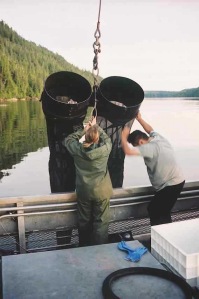
|
|||||||||||
Long-Term Goals and Research Hypotheses
 |
We propose to study the juvenile ecology of these two, once-large sockeye salmon populations. In so doing, we aim also to solidify the scientific basis for recovery planning and fishery management. The project will examine three scientific hypotheses. The first is that the supply of marine nutrients to the fjords where the juvenile sockeye salmon enter the marine environment has been altered. We shall focus on two aspects. We shall look for evidence of impacts of changes to coastal ocean processes – processes that may well be influenced by global climate change. We shall also further develop newly emerging knowledge on the role of returning adult salmon in the supply of nutrients to lake and fjord ecosystems. The possibility that nutrients from returning adult salmon can have an impact on fjordal ecosystems is, as yet, largely unexplored. The second hypothesis is that changes to the local climate may have affected these sockeye salmon populations through alterations to the thickness and integrity of freshwater surface layers in the fjords. We have preliminary evidence pointing to the critical nature of this habitat for juvenile sockeye salmon as they adjust to marine conditions. The third hypothesis is that changes to coastal ocean mixing processes have altered the |
Hence, there are reasons for investigating the role of climate change in the collapse of these sockeye salmon populations. There is also evidence that substantial local genetic adaptations have evolved in these and other sockeye salmon populations. Researchers have begun to question the ability of such locally adapted species to adjust to the rapid changes forecast to result from greenhouse gas emissions. This project will provide a solid opportunity to examine this general concern in the specific context of the preservation of a valuable renewable resource.
| To achieve these goals, we shall mount a multidisciplinary research project in partnership with Fisheries and Oceans Canada and Parks Canada aimed at the following objectives: (i) to study present fjord and coastal marine ecology through regular surveys of temperature, turbidity, nutrients, phytoplankton, zooplankton, and fish, emphasizing the juvenile sockeye salmon migration season; (ii) to gain insight on past ecological conditions, sockeye salmon spawning abundances, and their marine nutrient contributions, through the analysis of sediment cores extracted from the lakes and, where possible, the fjords; and (iii) to develop hydrodynamic and productivity |  |
We will also be developing novel methodology, primarily new statistical methodology to infer from otolith measurements the time of arrival in a fjord that contains an extensive freshwater surface layer, and the combined deployment of laboratory and statistical techniques to assess the role of marine-derived nutrients in sediments containing considerable terrestrial organic and inorganic debris.
Please read on to learn more about the specifics of the project -- return to Rivers Inlet Project Main Page and click on the links at the left-hand side of the page.